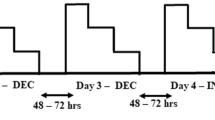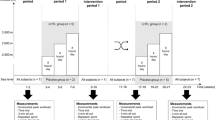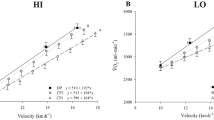Abstract
The purpose of this study was to estimate the percentage of the increase in whole body maximal oxygen consumption (\( \dot{V} \)O2max) that is accounted for by increased respiratory muscle oxygen uptake after altitude training. Six elite male distance runners (\( \dot{V} \)O2max = 70.6 ± 4.5 ml kg−1 min−1) and one elite female distance runner (\( \dot{V} \)O2max = 64.7 ml kg−1 min−1) completed a 28-day “live high–train low” training intervention (living elevation, 2,150 m). Before and after altitude training, subjects ran at three submaximal speeds, and during a separate session, performed a graded exercise test to exhaustion. A regression equation derived from published data was used to estimate respiratory muscle \( \dot{V} \)O2 (\( \dot{V} \)O2RM) using our ventilation (\( \dot{V} \) E) values. \( \dot{V} \)O2RM was also estimated retrospectively from a larger group of distance runners (n = 22). \( \dot{V} \)O2max significantly (p < 0.05) increased from pre- to post-altitude (196 ± 59 ml min−1), while \( \dot{V} \) E at \( \dot{V} \)O2max also significantly (p < 0.05) increased (13.3 ± 5.3 l min−1). The estimated \( \dot{V} \)O2RM contributed 37 % of Δ\( \dot{V} \)O2max. The retrospective group also saw a significant increase in \( \dot{V} \)O2max from pre- to post-altitude (201 ± 36 ml min−1), along with a 10.8 ± 2.1 l min−1 increase in \( \dot{V} \) E, thus requiring an estimated 27 % of Δ\( \dot{V} \)O2max. Our data suggest that a substantial portion of the improvement in \( \dot{V} \)O2max with chronic altitude training goes to fuel the respiratory muscles as opposed to the musculature which directly contributes to locomotion. Consequently, the time-course of decay in ventilatory acclimatization following return to sea-level may have an impact on competitive performance.



Similar content being viewed by others
References
Aaron EA, Seow CK, Johnson BD, Dempsey JA (1992) Oxygen cost of exercise hyperpnea: implications for performance. J Appl Physiol 72:1818–1825
Anholm JD, Johnson RL, Ramanathan M (1987) Changes in cardiac output during sustained maximal ventilation in humans. J Appl Physiol 63(1):181–187
Babb TG, Viggiano R, Hurley B, Staats B, Rodarte JR (1991) Effect of mild-to-moderate airflow limitation on exercise capacity. J Appl Physiol 70(1):223–230
Buskirk ER, Kollias J, Akers RF, Prokop EK, Reategui EP (1967) Maximal performance at altitude and upon return from altitude in conditioned runners. J Appl Physiol 23:259–266
Chapman RF, Emery M, Stager JM (1998) Extent of expiratory flow limitation influences the increase in maximal exercise ventilation in hypoxia. Respir Physiol 113:65–74
Collett PW, Engel LA (1986) Influence of lung volume on oxygen cost of resistive breathing. J Appl Physiol 61(1):16–24
Daniels J, Oldridge N (1970) The effects of alternate exposure to altitude and sea level on world-class middle-distance runners. Med Sci Sports Exerc 2:107–112
Dempsey JA, Romer L, Rodman J, Miller J, Smith C (2006) Consequences of exercise-induced respiratory muscle work. Respir Phys Neurobiol 28:242–250
Dill DB, Adams WC (1971) Maximal oxygen uptake at sea level and at 3090 m altitude in high school champion runners. J Appl Physiol 30:854–859
Faulkner JA, Daniels JT, Balke B (1967) Effects of training at moderate altitude on physical performance capacity. J Appl Physiol 23:85–89
Gore CJ, Hahn AG, Aughey RJ, Martin DT, Ashenden MJ, Clark SA, Garnham AP, Roberts AD, Slater GJ, McKenna MJ (2001) Live high: train low increases muscle buffer capacity and submaximal cycling efficiency. Acta Physiol Scand 173:275–286
Harms CA, Babcock MA, McClaran SR, Pegelow DF, Nickele GA, Nelson WB, Dempsey JA (1997) Respiratory muscle work compromises leg blood flow during maximal exercise. J Appl Physiol 82:1573–1583
Johnson BD, Saupe KW, Dempsey JA (1992) Mechanical constraints on exercise hyperpnea in endurance athletes. J Appl Physiol 73:874–886
Laymon AS, Stickford JL, Duke JW, Stager JM, Chapman RF, Stray-Gundersen J, Levine BD (2011) Hypoxic ventilatory response does not predict performance at moderate altitude in elite distance runners. Med Sci Sports Exerc 43(5):S58
Levine BD, Stray Gundersen J (2001) The effects of altitude training are mediated primarily by acclimatization, rather than by hypoxic exercise. Adv Exp Med Biol 502:75–88
Levine BD, Stray-Gundersen J (1997) “Living high-training low”: effect of moderate-altitude acclimatization with low-altitude training on exercise performance. J Appl Physiol 83:102–112
Martin BJ, Stager JM (1981) Ventilatory endurance in athletes and non-athletes. Med Sci Sports Exercise 13(1):21–26
Prommer N, Thoma S, Quecke L, Gutekunst T, Volzke C, Wachsmuth N, Niess AM, Schmidt W (2010) Total hemoglobin mass and blood volume of elite Kenyan runners. Med Sci Sports Exerc 42(4):791–797
Rusko HK, Tikkanen HO, Peltonen JE (2004) Altitude and endurance training. J Sport Sci 22:928–944 (Discussion 945)
Sato M, Severinghaus JW, Powell FL, Xu F, Spellman MJ Jr (1992) Augmented hypoxic ventilatory response in men at altitude. J Appl Physiol 73(1):101–107
Schoene RB, Lahiri S, Hackett PH, Peters RM, Milledge JS, Pizzo CJ, Sarnquist FH, Boyer SJ, Graber DJ, Maret KH (1984) Relationship of hypoxic ventilatory response to exercise performance on Mount Everest. J Appl Physiol 56:1478–1483
Schoene RB, Roach RC, Hackett PH, Sutton JR, Cymerman A, Houston CS (1990) Operation Everest II: ventilatory adaptation during gradual decompression to extreme altitude. Med Sci Sports Exerc 22:804–810
Stray-Gundersen J, Levine BD (1997) “Living high-training high and low” is equivalent to “living high-training low” for sea level performance. Med Sci Sports Exerc 29:S136
Stray-Gundersen J, Mordecai N, Levine BD (1995) O2 transport response to altitude training in runners. Med Sci Sports Exerc 27:S202
Stray-Gundersen J, Chapman RF, Levine BD (2001) “Living high-training low” altitude training improves sea level performance in male and female elite runners. J Appl Physiol 91:1113–1120
Townsend NE, Gore CJ, Hahn AG, McKenna MJ, Aughey RJ, Clark SA, Kinsman T, Hawley JA, Chow C (2002) Living high-training low increases hypoxic ventilatory response of well-trained endurance athletes. J Appl Physiol 93:1498–1505
Townsend NE, Gore CJ, Hahn AG, Aughey RJ, Clark SA, Kinsman TA, McKenna MJ, Hawley JA, Chow CM (2005) Hypoxic ventilatory response is correlated with increased submaximal exercise ventilation after live high, train low. Eur J Appl Physiol 94:207–215
Turner LA, Tecklenburg-Lund SL, Chapman RF, Stager JM, Wilhite DP, Mickleborough TD (2011) Inspiratory muscle training lowers the oxygen cost of voluntary hyperpnea. J Appl Physiol 112:127–134
Wilber RL (2007) Application of altitude/hypoxic training by elite athletes. Med Sci Sports Exerc 39:1610–1624
Acknowledgments
This study was supported by a grant from the AAU/Bell-Updyke-Willett Kinesiology Research Fund, Indiana University School of HPER.
Conflict of interest
None of the authors of this article has any conflicts of interest or financial conflicts to report.
Author information
Authors and Affiliations
Corresponding author
Additional information
Communicated by Guido Ferretti.
Rights and permissions
About this article
Cite this article
Wilhite, D.P., Mickleborough, T.D., Laymon, A.S. et al. Increases in \( \dot{V} \)O2max with “live high–train low” altitude training: role of ventilatory acclimatization. Eur J Appl Physiol 113, 419–426 (2013). https://doi.org/10.1007/s00421-012-2443-4
Received:
Accepted:
Published:
Issue Date:
DOI: https://doi.org/10.1007/s00421-012-2443-4




